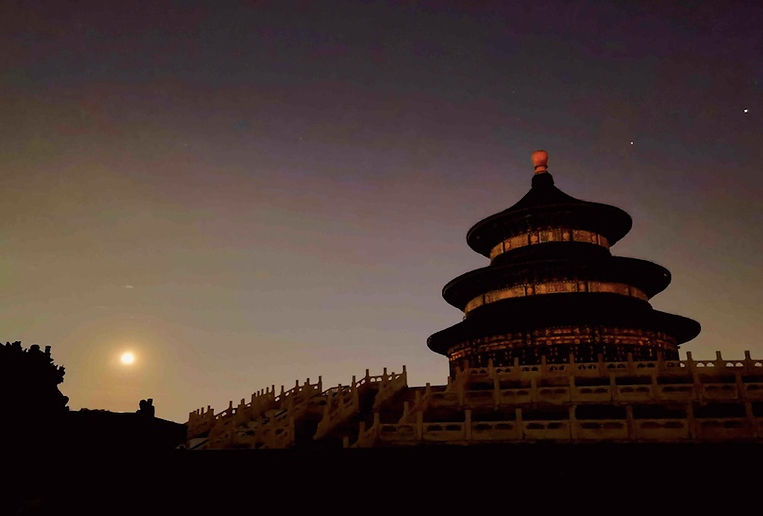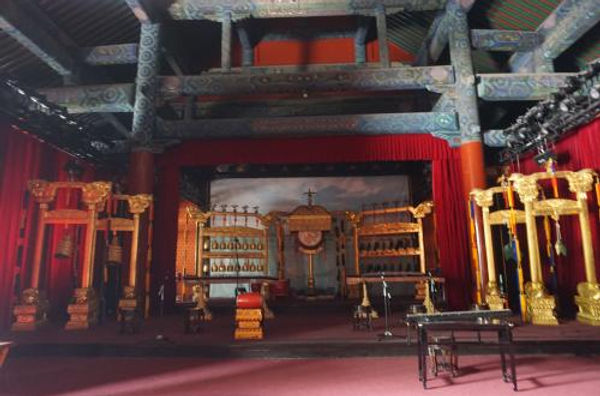Temple of Heaven — Ancient Imperial Sacrificial Building Complex of Ming and Qing Dynasties
The Temple of Heaven served as a sacred place for emperors of the Ming Dynasty (1368–1644) and the Qing Dynasty (1636–1912) to conduct sacrificial ceremonies to heaven.
It stands as a masterpiece with exceptional cultural and architectural values.
Today, it is recognized as a UNESCO World Heritage Site, representing the imperial heaven worship altar in Chinese history.
It holds the distinction of being the world's largest existing building complex dedicated to offering sacrifices to heaven.

Hall of Prayer for Good Harvests on the Qigu Altar of the Temple of Heaven or Tiantan in Beijing, Photo from Official Site of Tiantan Park.
Relationship Between Temple of Heaven and Other Imperial Buildings
History of the Temple of Heaven
Symbolism and Cosmology in the Layout and Architectural Designs
Other Notable Buildings and Attractions within the Temple of Heaven Complex

Ancient Building Complex of the Temple of Heaven, Photo from Official Site of Tiantan Park.
Relationship Between Forbidden City, Temple of Heaven, and Other Imperial Sacrificial Temples
The Forbidden City, constructed from 1406 to 1420 at the center of Beijing, served as the imperial palace where emperors worked and lived.
Surrounding the Forbidden City are five altars for emperors to hold imperial sacrificial ceremonies, based on Yin Yang and Five Elements theories.

Exquisite Roof Decorations (Tianhua and Zaojing) of the Hall of Prayer for Good Harvests or Qiniandian of the Temple of Heaven, Photo by Wang Qiong.
-
The Temple of Heaven (or Tian Tan) in the southeast, built in 1420, served as the place for worshiping heaven on Winter Solstice.
-
The Temple of Agriculture (or Xiannong Tan) in the southwest, constructed in 1420, was dedicated to worshiping Shennong, the Deity of Agriculture, in early spring.
-
The Temple of Earth (or Di Tan) in the north, built in 1530, was established for worshiping the earth on Summer Solstice.
-
The Temple of Sun (or Ri Tan) in the east, constructed in 1530, was designed for worshiping the sun on Spring Equinox.
-
The Temple of Moon (or Yue Tan) in the west, constructed in 1530, was dedicated to worshiping the moon on Autumn Equinox.

Yuanqiu or Circular Mound Altar of the Temple of Heaven, Photo from Official Site of Tiantan Park.
The Temple of Heaven was the most sacred among these five sacrificial temples.
Throughout history, Chinese Emperors have been respected as "Sons of Heaven" who were obliged to rule the country by the Mandate of Heaven.
The "Heaven" is Haotian Shangdi.
From the Zhou Dynasty (1046 BC — 256 BC) to the last feudal empire, the Qing Dynasty (1636 — 1912), worshiping heaven was the most important and grandest imperial sacrificial ceremony exclusively held by emperors.
Therefore, the Temple of Heaven, covering an area of 2,730,000 square meters, is approximately four times larger than the imperial Forbidden City (720,000 square meters).
It is situated to the southeast of the Forbidden City, a location believed to be the brightest with the highest Yang power, according to the ancient masterpiece I Ching.

At Noon of Winter Solstice, Sunlight Would Shine on the Memorial Tablet of Haotian Shangdi, the Paramount Deity in ancient Chinese culture that is Enshrined in the Main Hall of the Temple of Heaven.
History of the Temple of Heaven
Under the command of the Yongle Emperor, the Temple of Heaven and Earth (or Tiandi Tan) was constructed in 1420 to offer sacrifices to Heaven and Earth.
Later, the Jiajing Emperor insisted that heaven and earth should be worshipped separately, according to ancient rituals.
So from 1530 to 1534, he changed the altar's name to the Temple of Heaven and renovated it to offer heaven sacrifice and pray for good harvests.
Meanwhile, he commanded to build the Temple of Earth in the north to worship the Earth exclusively.

Hall of Prayer for Good Harvests or Qiniandian Under the Moon, Photo from Official Site of Tiantan Park.
Centuries later, in 1751, the Qianlong Emperor changed the main hall's name and renovated and expanded the temple complex several times.
In 1900, the Eight-Nation Alliance occupied the Temple of Heaven, caused damage to buildings and ancient plants, and took away many valuable ritual relics preserved there.
After the Qing Dynasty ended in 1912, this imperial sacrificial altar gradually opened to the public, and more resources have been invested in preserving these masterpieces in recent decades.
In 1998, it was inscribed as a UNESCO World Cultural Heritage, as a perfect combination of exceptional architecture and landscape, ancient sacred rites, and modern leisure activities.

Symbolism and Cosmology in the Layout and Architectural Designs of the Temple of Heaven
An important concept in ancient Chinese cosmology is the idea of Round Heaven and Square Earth.
The Temple of Heaven features two main altars:
-
Yuanqiu Altar in the south for worshiping heaven
-
Qigu Altar in the north for praying for good harvests
As a result, the inner wall of Yuanqiu is circular, symbolizing heaven, while the inner wall of Qigu is square, symbolizing the earth.

Yuanqiu Altar in the South and Qigu Altar in the North in Aerial Photography of Temple of Heaven, Photo from Jizheng/Longhang Aerial.
Vermilion Steps Bridge or Danbiqiao
These two altars are connected by the Vermilion Steps Bridge, or Danbiqiao, with three designated paths for deities (in the middle), emperors (in the east), and officials (in the west) to walk during the grand ceremony.

Danbiqiao or Vermilion Steps Bridge, Photo from Official Site of Tiantan Park.
Yuanqiu Altar or Circular Mound Altar
Yuanqiu Altar, also known as the Circular Mound Altar, is where emperors offer sacrifices to heaven on Winter Solstice.
It consists of three marble layers representing heaven, earth, and humanity.
Each layer features nine stairs in every direction, and the number of railings and plates on each layer is either nine or a multiple of nine.
This aligns with the significance of the Number 9 in the I Ching (or Book of Changes), where it is considered the largest single digit of the Yang force, symbolizing heaven, paramount power, and the majesty of emperors.
In ancient Chinese mythology, there are nine layers of heaven, referred to in Chinese as Jiu Chong Tian.

Yuanqiu or Circular Mound Altar.
Celestial Heart Stone or Heart of Heaven
At the center of the top layer of the Yuanqiu Altar is the Celestial Heart Stone, also known as the Heart of Heaven (Tianxinshi in Chinese), where emperors would stand during worship ceremonies to heaven.
While standing on the stone and speaking, echoes from all sides would amplify the emperor's voice, creating a resonant effect that made it sound as if the whole world were responding simultaneously.

Tianxinshi or Celestial Heart Stone or Heart of Heaven on Yuanqiu Altar, Photo from Official Site of Tiantan Park.
Hall of Prayer for Good Harvests or Qiniandian
Hall of Prayer for Good Harvests, also known as Qiniandian, stands as the central and prominent structure within the Qigu Altar.
It served as the sacred space where emperors fervently prayed for bountiful harvests during the month of January in the Traditional Chinese Calendar.

Hall of Prayer for Good Harvests or Qiniandian on Qigu Altar, Photo from yktour.
Symbolism and Facts of the Hall of Prayer for Good Harvests
-
Its circular blue roofs represent heaven, while the three tiers symbolize heaven, earth, and the secular world.
-
The four main pillars in the inner circle represent the four seasons.
-
The 12 pillars in the middle circle symbolize the 12 months of each year, while the outer circle denotes the 12 shichen (every 2 hours constituting one shichen in ancient China) of each day.
-
The 24 pillars in the middle and outer circles correspond to the 24 Solar Terms.
-
The total of 28 pillars aligns with the 28 Lunar Mansions in ancient Chinese Astrology.

Section View of Hall of Prayer for Good Harvests or Qiniandian, Picture from Li Qianlang.
Seven Star Stone Group or Qixingshi
The Seven Star Stones, or Qixingshi, located to the east of the Hall of Prayer for Good Harvest, were arranged in the shape of the Big Dipper by Emperor Jiajing in 1530.
They represent the seven peaks of Mount Tai, the sacred mountain where the most accomplished emperors held the holiest heaven worship Fengshan Ceremony.
Centuries later, the Qianlong Emperor added another smaller stone to represent his Manchu ancestor's holy mountain, the Changbai Mountains.

Qixingshi or Seven Star Stones, Photo by Li Hengying.
Other Notable Buildings and Attractions within the Temple of Heaven Complex
Imperial Vault of Heaven or Huangqiongyu
The Imperial Vault of Heaven, or Huangqiongyu in the north of the Yuanqiu Altar, first constructed in 1530 and renovated in 1752, was to enshrine memorial tablets of deities that were worshipped in the ceremony.

Huangqiongyu or Imperial Vault of Heaven, Photo from Official Site of Tiantan Park.
Echo Wall or Huiyinbi
Echo Wall, or Huiyinbi, is the enclosing wall of the Imperial Vault of Heaven.
Inside the Echo Wall are Three Echo Stones (Sanyinshi) and Dialogue Stone (Duihuashi).
Together, they produced a series of fascinating acoustic phenomena, which were considered mysterious in ancient times.
Today, science has solved those puzzles about how the stone walls reflect sound waves; however, hearing someone's whispers from far away and trying different echoes are still interesting to experience.

Part of Echo Wall or Huiyinbi, Photo by Tiankong.
Hall of Abstinence or Zhaigong
The Hall of Abstinence, or Zhaigong, located to the west of the two altars, was constructed in 1420 for emperors to observe abstinence from meat, alcohol, music, and sex three days prior to the worship ceremony.

Gate of Hall of Abstinence or Zhaigong, Photo by yang vision.
Long Corridor
According to ancient rites, the Divine Kitchen that prepares sacrificial food should keep a certain distance from the sacred altar.
Hence, the Long Corridor that connects the Qigu Altar and Divine Kitchen is a passageway to transport food to the worship ceremony while ensuring that everything is not contaminated by rain, wind, or snow.

Part of the Long Corridor
Divine Music Administration or Shenyueshu
Divine Music Administration, or Shenyueshu, was the place to practice Taoist music and dances performed in worship ceremonies.
It was constructed in 1420 and is located on the west side of the Temple of Heaven.
The Divine Music Administration was initially managed by professional Taoists during the Ming Dynasty (1368 — 1644) and later changed to officials during the Qing Dynasty (1636 — 1912).

Musical Instruments in the Divine Music Administration or Shenyueshu.
You Might Also Like:
Temple — Religion, Culture, and Art Across Time
Chinese Palaces — Architecture and Art of Imperial Feats
Chinese Emperors — Ultimate Introduction to Emperors of Ancient China
Historic Military Defense System and Cultural Icon — The Great Wall of China
Cultural Symbol Across Time and Space — Yellow River or Huang He River
Longest River of China — Yangtze River or Chang Jiang River
Guarding Warriors of the Mausoleum of the First Qin Emperor — Terracotta Army
Ancient Trade Routes That Connected the East and West — Silk Road
The Largest Existing Imperial Palace and Witness of History — Forbidden City
Magnificent Buddhism Palace on Tibetan Plateau — Potala Palace
Chinese Architecture — Tradition, Characteristics, Function, and Style
Chinese Gardens — Aesthetics, Philosophy, and Architecture in Nature
Imperial Garden with Picturesque Views — Summer Palace
Classical Southern Garden of Borrowed Sceneries — Lingering Garden
Artful Southern Style Classic Garden — Humble Administrator Garden
Royal Mountain Resort In Picturesque Natural Views — Chengde
Pagodas that Trying to Reach the Sky — Origin, History, and Facts
List of Exceptional Chinese Pagodas
Royal Stone Carving Museums on Cliff — Longmen Grottoes
Exceptional Buddhist Art Gallery on Silk Road — Mogao Grottoes
Localization and Secularization of Buddhist Cave Art — Yungang Grottoes
Cultural Meanings of Extraordinary Attractions in China
Legend, History, and Culture of Chinese Lakes
History and Culture of Magnificent Mountains in China
